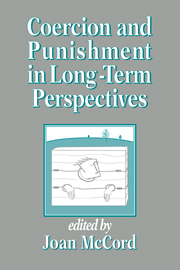Book contents
- Frontmatter
- Contents
- List of contributors
- Acknowledgments
- 1 Introduction: coercion and punishment in the fabric of social relations
- I Mental health, coercion, and punishment
- II Family socialization practices and antisocial behavior
- III Aggression and coercion in the schools
- IV Deviance, crime, and discipline
- V Measuring and predicting in studies of coercion and punishment
- Name index
- Subject index
1 - Introduction: coercion and punishment in the fabric of social relations
Published online by Cambridge University Press: 29 September 2009
- Frontmatter
- Contents
- List of contributors
- Acknowledgments
- 1 Introduction: coercion and punishment in the fabric of social relations
- I Mental health, coercion, and punishment
- II Family socialization practices and antisocial behavior
- III Aggression and coercion in the schools
- IV Deviance, crime, and discipline
- V Measuring and predicting in studies of coercion and punishment
- Name index
- Subject index
Summary
Democracy depends heavily on consensus. Persuasion, coercion, and fear provide the means for bringing about that consensus and jointly account for much of the education or training of children to participate in society. Children must be taught to act appropriately – in ways that differ from society to society and from context to context. How they are taught remains something of a mystery.
This book developed from the ways in which researchers responded to the mystery. Successful socialization can be viewed as subtle coercion, possibly making punishment unnecessary. The question of how best to socialize children so that they function well is a large and crucial question that has fascinated parents, educators, philosophers, and psychologists for centuries.
Persuasion seems a natural adversary of punishment from the perspective of a teacher or a parent. If children can be persuaded to do as the adult wishes, no punishment need be considered. A child persuaded to help clean the home need not be punished for having failed to do so. Although a threat of punishment might be persuasive, the boundaries between persuasion and punishment remain reasonably clear.
Coercion can be less clearly identified. Conceptually, coercion implies forcing people to do what they would not otherwise have done. For example, when an individual is forced at gunpoint to do something he or she would not otherwise choose to do, the action can be described as one of coercion.
- Type
- Chapter
- Information
- Publisher: Cambridge University PressPrint publication year: 1995
- 2
- Cited by

